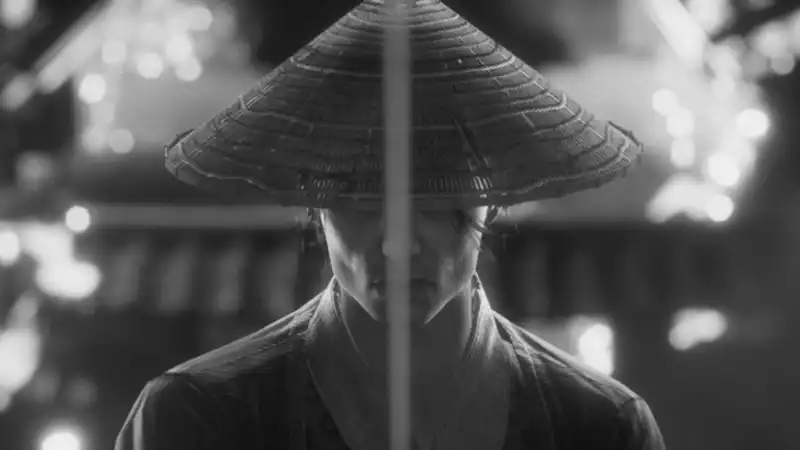"Trek to Yomi" mimics the style of Akira Kurosawa's iconic black-and-white samurai films. Well, "Trek to Yomi" goes where Kurosawa's film did not. But the journey there is full of glitches, and I only endured the detailed, floating combat to see where the samurai's descent into madness would lead him.
After the town is ravaged by bandits, the hero, Hiroki, must decide whether to remain bound by his duty, protect his loved ones, or seek revenge. It's a classic samurai tale, but the story is well crafted, and Hiroki faces his personal demons (also literal demons), decisions that will affect how this samurai tragedy will end for me. All of the Japanese voice actors give vivid performances, with Hiroki's voice actor in particular doing a particularly good job of portraying his downward spiral into anger and regret.
I also like the supernatural elements of Trek to Yomi. Hiroki straddles the line between life and death, and the second half of the game is a literal journey through hell. This reminds me of the supernatural elements of Uncharted 1 and Uncharted 2. Monsters and ghostly apparitions caught me off guard, thinking the world was more down-to-earth. It's not overbearing, but adds a fascinating mysticism.
Unfortunately, combat is weightless and repetitive, and most of the movement in Trek to Yomi is spent swinging swords. I spent most of the game repeating the same combos, occasionally parrying enemy attacks to create an opening. Long-range weapons like shurikens and arrows were limited, and I picked up a few new sword techniques along the way, like quick barrages and piercing armored enemies. All of them felt pointless when the same parry and slash routines could basically kill all ordinary enemies.
I was constantly frustrated by how difficult it was to tell that I had parried an attack. Visual feedback was scarce and vocal cues were choppy, so I could not consistently take advantage of the gaps I created. Sometimes a sword slash would clearly hit an enemy, yet there would be no reaction. Is he hiding a hitbox inside his body?
The controls and wooden animation are no match for the cinematic dueling fluidity that "Trek to Yomi" so badly wants to emulate. After defeating an enemy, you can use the R button to turn around and face the enemy behind you, but nothing happens. To make Hiroki recognize the action, the R button had to be pressed several times, and wasting a few seconds with his back turned would reduce his HP and sometimes kill him.
Dodges were also inconsistent: sometimes you would roll behind an enemy, sometimes you would hit a brick wall.
The types of enemies were also not Trek's strong suit. First you fight bandits, then supernatural creatures and ghostly apparitions. These enemies use the exact same character models throughout the game. The bosses were a valuable break from the monotony and were the only enemies that demanded more from me than just slapping on the same combos. One boss forced me to constantly adjust my positioning on the battlefield. If I leaned too far to one side of the stage, I could be blown off by a wind attack, resulting in an instant game over.
Exploration mostly followed a linear path from story beat to story beat. Sometimes simple puzzles stood in the way, but they were all of the same design, so they were easy to solve.
Outside of combat, exploration was done with a fixed camera with 3D movement, allowing for collectibles and upgrades such as increased stamina and strength. There are two paths: the path that advances the story and the path that leads to some kind of collectible or upgrade. The problem here is that sometimes it's hard to tell which is which.
If I want to find as many upgrades as possible to give Hiroki an edge in battle, I choose one path, stick with it, and hope I find what I am looking for. But if I choose the critical path, I will fall off a ledge from which I cannot stand. There are save points before and after nearly every encounter in Trek to Yomi, so resuming from a checkpoint is usually an easy option. However, it is odd and counterintuitive to have to save-come just to explore such alternative paths.
Were it not for the progress obstruction glitch, Yomi's design misdemeanor might have been forgivable. After jumping off the ledge, he sometimes tore up the floor. On other occasions, my character would disappear into thin air after falling from a collapsed roof and be nowhere to be found. The only way to try again was to restart from a checkpoint or quit the game and restart.
There were a few times when encounters with enemies simply would not activate, and sometimes enemies that were supposed to spawn would not spawn. I had to restart the game every time I died and wanted to fight again because otherwise the arena would be empty.
For all its visual grandeur, "Trek to Yomi" is not very interesting. It tries to tell a story worthy of a samurai drama, but the combat never graduates from the tedious part of the sword training montage.
.

Comments